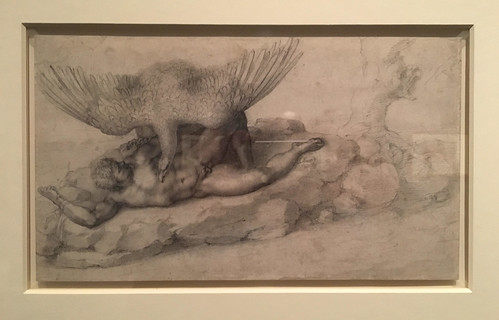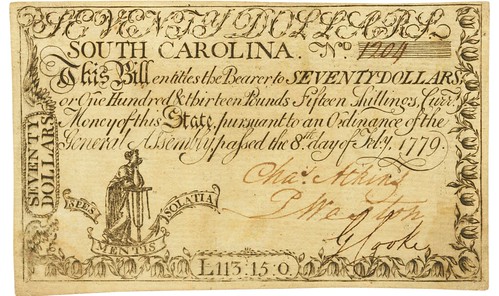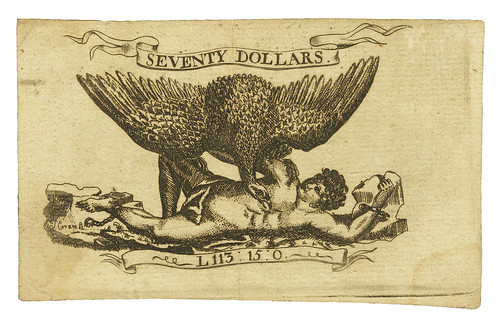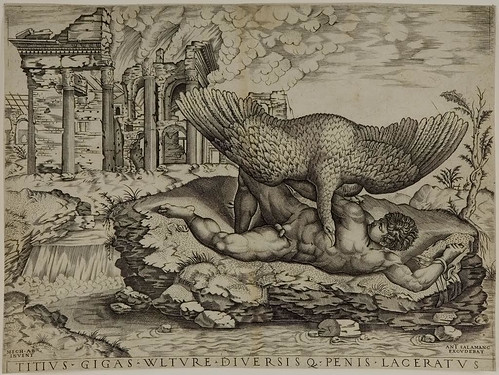
PREV ARTICLE
NEXT ARTICLE
FULL ISSUE
PREV FULL ISSUE
MICHELANGELO, BEATRIZET, AND THOMAS CORAMMaureen and Stu Levine submitted this excellent article relating to the source and inspiration for an image on South Carolina colonial currency. Thanks! -Editor
Michelangelo, Beatrizet, and Coram During last week’s trip to the New York International Numismatic Convention, we visited the once-in-a-lifetime Michelangelo exhibit at the Metropolitan Museum of Art. One small black chalk drawing (19 x 33 cm) caught our attention:  Michelangelo’s drawing of The Punishment of Tityus The similarity of Michelangelo’s drawing of The Punishment of Tityus to Thomas Coram’s engraving of Prometheus Bound on the $70 note from South Carolina’s February 8, 1779, issue was immediately evident:   Thomas Coram's Prometheus Bound on South Carolina $70 note From the Eric P. Newman Collection The first question that came to mind was: Who is Tityus and how does he relate to Prometheus? Both are immortal figures from Greek mythology who are sometimes confused with one another because they received similar punishments from Zeus for very different infractions. Various authors have different versions of their deeds, but for the sake of brevity, we will simplify. The Titan Prometheus came to the aid of mankind at the expense of the gods, and we tend to consider him as a hero. The giant Tityus, son of Zeus and his mortal consort, Elara, attempted to rape the goddess Leto, mother of Apollo and Artemis; therefore, he is reviled. Prometheus was chained to a rock with an eagle relentlessly feeding on his ever-regenerating liver. For his base act, Tityus was bound to the earth in the underworld with two vultures (although Michelangelo depicts only one bird) eating his liver as it regrew for eternity. The second question is: Would Coram have been familiar with the Michelangelo drawing? Certainly not the original, which was first inventoried in 1810 as part of the British Royal Collection at Windsor Castle. A reproduction would have provided the source for Coram’s engraving, but which one? Many other artists have used Tityus or Prometheus as their subjects in paintings, drawings, and engravings. Michelangelo’s drawing was copied (and recopied) in various media: chalk, engraving, carving (on rock crystal). However, according to the Museo del Prado’s website, “[Nicolas] Beatrizet’s engraving resulted in the immediate dissemination of Michelangelo’s composition.” We posit as Coram’s source Tityus Gnawed by the Vulture, by Nicolas Beatrizet:  Beatrizet's Tityus Gnawed by the Vulture Harvard Art Museums/Fogg Museum, Gift of William Gray from the collection of Francis Calley Gray According to the Fine Arts Museums of San Francisco website, Beatrizet was born in France and worked as a “reproductive engraver” in Rome from approximately 1550-1565. In addition to Michelangelo’s Tityus, he also fashioned engravings after the three other drawings that the artist presented to Tomasso de’Cavalieri in 1532-3: A Children’s Bacchanal, The Fall of Phaeton, and Rape of Ganymede. The third question is: Why is the figure in the Beatrizet engraving oriented differently (with his head at the right) than that in the Michelangelo? A brief study of Beatrizet’s other engravings of Michelangelo’s drawings shows that this is also the case in the Ganymede; thus, two of the four presentation drawings were oriented as mirror images as was his engraving of Michelangelo’s Archers Shooting at a Herm. The reason for the variance with the original drawings is unknown. Where Coram encountered the Tityus is also not known. Biographical information indicates that, although essentially without formal training, he did have a painting instructor for a time by the name of Henry Benbridge. Since Benbridge had been studying in Rome prior to teaching Coram in Charleston, it is possible that he brought Italian books or illustrations with him. The last question is: What comments have been made about this self-taught engraver’s skill? First, Eric P. Newman, in the Early Paper Money of America, writes, “The artistry of Thomas Coram of Charleston, South Carolina, was demonstrated by elaborate mythological vignettes on the February 8, 1799 issue of his State". We have located two other sources, with opinions that are diametrically opposed. Mantle Field, in the 1917 edition of American Engravers Upon Copper and Steel, said, “The design is well drawn and represents ‘Prometheus Bound,’ but the engraving is poorly executed in line.” On the other hand, Clarence S. Brigham, in the October 1951 Report of the Council of the American Antiquarian Society’s proceedings, said: “No other colony obtained such excellent engraving as South Carolina, and its issue of February 8, 1799, with the figures of Atlas, Prometheus, and Hercules, signed by Thomas Coram, compares with the best of eighteenth-century American engraving.” We have always been impressed by the beauty of the Coram notes, and find them all the more fascinating due to the discovery of Michelangelo’s inspiration. To read the complete lot description, see:  Wayne Homren, Editor The Numismatic Bibliomania Society is a non-profit organization promoting numismatic literature. See our web site at coinbooks.org. To submit items for publication in The E-Sylum, write to the Editor at this address: whomren@gmail.com To subscribe go to: https://my.binhost.com/lists/listinfo/esylum All Rights Reserved. NBS Home Page Contact the NBS webmaster 
|